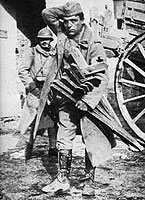Schrift: größer/kleiner
Inhaltsverzeichnis
Sie sind hier: WirRheinländer > english version > First World War (1914 - 1918) > Sedan as a Symbol
First World War (1914 - 1918)
Sedan as a Symbol
As far as the horror of a matériel battle of the First World War is concerned, Verdun is the place which remains embedded in the memory of the French and the Germans. However, some military historians describe the town of Sedan as the place which decided the fate of France and Germany, because of strategic decisions taken in several wars.
In the First World War Sedan remained occupied by German troops for 4 years. Before French and American troops were able to capture the town in November 1918, the armistice came into effect. No strategically important decisions were made in this place in the war.
This appeared to be quite different from the preceding war of 1870/71, or from the Second World War, as far as the role of Sedan is concerned:
In 1870 the Prussian Chief of General Staff, von Moltke, by means of a clever operational campaign, succeeded in encircling the French Army at Sedan, including the Emperor Napoleon III, and in forcing them to capitulate on 2nd September. The date was to be deeply embedded in the collective memory of society under the Kaisers as "Sedan Day".
 In the positional warfare of the First World War, the actions of the military in wide-ranging operations were effectively cancelled out by technology. Tactical weapons, like machine-guns, artillery, poison gas soon made any extensive movement almost impossible. Every metre of territory won had to be gained at the cost of countless losses. It was not until tanks were deployed by the Allied side, as a supporting weapon of the infantry, that there was movement on the fronts, which would at long last contribute to the military defeat of the German Empire in 1918.
In the positional warfare of the First World War, the actions of the military in wide-ranging operations were effectively cancelled out by technology. Tactical weapons, like machine-guns, artillery, poison gas soon made any extensive movement almost impossible. Every metre of territory won had to be gained at the cost of countless losses. It was not until tanks were deployed by the Allied side, as a supporting weapon of the infantry, that there was movement on the fronts, which would at long last contribute to the military defeat of the German Empire in 1918.
In 1940, at the beginning of the Second World War, it was intended that Sedan, in the "campaign" against France (from May 1940), should once again play a decisive part. The German generals von Manstein and Guderian had drawn the right conclusions from their experience in the First World War and recognized the role of tanks as autonomous weapons. The Allies also believed in the existence of a new version of the so-called Schlieffen Plan during the Second World War. By the deception of a supposedly strong north wing, amalgamated tank units attacked as autonomous divisions, moving through the Ardennes and crossing the river Meuse at Sedan on 14th May. At that point they broke though the French front with the element of surprise and stormed forward in a "scything" movement towards the French coast. Thereby they cut off the majority of French and British units in Belgium and northern France, severing them from their commanders. In Sedan this operation led to the coining of the word "Blitzkrieg" by the Germans, but finally led to their hubris by trying to win every campaign with this tactic alone.


